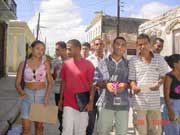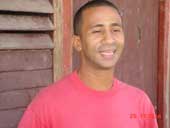





|
|
MANZANILLO.— “Es verdad, yo vendí dólares en la acera”, admite con cierto halo de remordimiento después de la pertinaz interrogante. “Estuve diez años desempleado y en ese tiempo inventé para ganar dinero”, remarca. Sus confesiones parecen inciertas hoy en la estrecha oficina, que este día de octubre se ha congestionado de dinámicos dirigentes estudiantiles, cuyas semblanzas también tuvieron torceduras y sobresaltos antaño. En aquella época casi ninguno estaba integrado a la “vida institucional” y él, en específico, era un peón de la economía furtiva, siempre proclive —según sus propias palabras— a “desviarte a otras cuestiones peores. “Legalmente mi casa se sostenía con el salario de mi padre: poco más de cien pesos. Yo había sido zapatero remendón varios años, pero no me fue bien monetariamente en ese trabajo por cuenta propia, y pasé a vender divisa en la calle. Mejoré las finanzas, la ropa y los zapatos; no lo niego. Pero emocionalmente jamás me sentí tranquilo”. VIRAJE
“Me sucedió algo parecido, estuve trabajando en una cafetería particular en Matanzas, ‘luché’ la vida de varias maneras y regresé de vago, con un inmenso vacío espiritual”, cuenta Miguel. “Ayudé a mi esposo en la fotografía, hice algunos trabajos domésticos que me reportaban ganancias. Mas, andaba mal por dentro”, dice Yailés. “Pasé cinco años desvinculado; labré la tierra un tiempo, pero me sentía inútil y desorientado”, señala Iván. La paz de ánimo... el viraje de las existencias de Jorge Luis y de quienes lo circundan ahora en este apretado local en la UJC de Manzanillo, que sirve de puesto de mando de la FEEM, sobrevino en septiembre de 2001, cuando ingresaron al Curso de Superación integral para jóvenes, un proyecto que ha sido brújula para el cambio no solo de antiguos desvinculados.
“Sufrí una depresión enorme porque perdí a mis padres, mi ex esposo fue a prisión y luego también falleció. El aula alivió mis dolencias físicas y sentimentales”, expone. Pero más allá de evoluciones individuales como las de esta muchacha o las de Jorge Luis, quien en la actualidad es militante de la Juventud y presidente municipal de la FEEM, están las mutaciones colectivas. Programas de este corte, incomprendidos por algunos al principio, trastocaron por completo el mapa social cubano. Y devinieron estrategias para atenuar o prevenir males como el parasitismo a escala grupal. En un territorio como Manzanillo, que llegó a exhibir tasas de desempleo cercanas al diez por ciento, estas experiencias ayudaron a limpiar el ambiente social y a mejorar la proyección general de sus habitantes, en especial la de los jóvenes. “Los vendedores del mercado negro no han desaparecido ni mucho menos, pero hoy la ciudad tiene muchas menos esquinas ‘contaminadas’; hay muchas más personas que hablan de cosas útiles, de futuras carreras universitarias, de cursos y libros. Y algunas de ellas antes andaban por malos caminos...”, reconoce el propio Jorge. Numéricamente la prueba del cambio está en que hace dos años Manzanillo contaba, según registros oficiales, con unas 1 200 personas de 16 a 29 años sin vínculo laboral o estudiantil y hoy son menos de 500. “En mayo de 2002 en Granma había unos 12 700 jóvenes desvinculados y ahora hay cerca de 2 420”, reafirma Maliedys Borrero, trabajadora social que atiende esta esfera en el puesto de mando de la provincia. “De esa cifra, 214 han expresado su deseo de no incorporarse ni al estudio ni a una labor útil a la sociedad, pero mantenemos la persuasión, que siempre da frutos”. SIN ESPEJISMOS El Curso..., fuente del inédito y hermoso empleo de estudiar, no ha resultado el único abridor de puertas a jóvenes antes desmotivados. En los últimos tiempos, miles de jóvenes de la nación, incentivados por otros programas ventajosos, se han empleado como profesores emergentes de Cultura Física, o en la construcción, la gastronomía, hospitales, peluquerías, organopónicos y otras faenas agrícolas. Léster, por ejemplo, era hace un lustro un vendedor de frituras frente a una secundaria básica de Cauto Cristo, y hoy es distinguido profesor de Educación Física en ese propio centro docente. Y Oslaida era una “manicuri” ocasional que llevaba seis años sin hacer nada y ahora es una eficiente asistente de Estomatología en un policlínico de Bayamo. Ambos apoyan la idea de que sus barrios han mudado la piel a la par de ellos. “Mi calle era la más aburrida del mundo, repleta de amas de casa que todos los días conversábamos de los mismos temas. Ya no existen esos clubes de charlas”, sentencia ella. Para Frank Ferrer, jefe de Trabajo Social en Granma, la causa de reducción del desempleo juvenil —y por tanto de la tendencia al delito y al “invento”— radica en el aprovechamiento al máximo de los programas sociales. “Existe una relación muy estrecha entre nuestro frente, el Ministerio de Trabajo en la provincia y la Dirección de Educación; estudiamos y buscamos todas las variantes a diario para que no haya jóvenes en el limbo de la vagancia”. No obstante, él mismo reconoce que está latente la posibilidad de que algunos muchachos sean agentes activos de la economía subterránea por el día —vendedores de cámaras de bicicleta o de medias— y estudiantes de algún curso por la noche o viceversa. En ese caso no pueden surgir espejismos ni loas excesivas, y se torna imprescindible la mirada crítica. “Por eso en Granma hemos empezado a visitar a cada uno de los jóvenes y no solo a aquellos sin vínculo laboral o estudiantil. Queremos saber cómo piensa cada uno, qué expectativas tiene, qué desea, cómo ven el presente y el futuro. “Cuando hayamos concluido ese abarcador y ambicioso trabajo tendremos una mejor herramienta para realizar nuestra labor social”, expresa Ferrer. Otra arista es que en el deseo de integrar a los más nuevos se olvide un tanto a aquel segmento de desvinculados de más de 30 años, cuya indiferencia hacia nuestros asombrosos programas resulta visible. Y un punto neurálgico, que merece estudios serios y atinados, está relacionado con la cifra de jóvenes sin opciones laborales después de concluir las clases en politécnicos, escuelas de oficios y conducta. “De estos centros y del Servicio Militar egresan muchachos que luego no tienen ubicación o reciben opciones ajenas a su profesión. Esas son las principales fuentes del desempleo en menores de 25 años”, recalca Frank. Esta realidad sugirió otros proyectos para esos segmentos, anunciados recientemente por la dirección del país. Cuba vive en constante revolución. ENSUEÑOS Nada peor que vivir en la soledad espiritual, sin sueños y sin metas concretas. Así estaban Jorge Luis, Miguel, Lili..., hasta que fueron “tocados” por los nuevos programas de la Revolución. Otros, como Léster, ya traspasaron los portales soñados. Esta mañana Miguel se imagina con una pulcra bata blanca de médico, Lili con una imponente toga y Jorge con un teclado enfrente, como un feliz informático. Ese es el gran acierto de este despertar nacional de pensamientos y realizaciones que ya lleva cinco años: regalarles sueños individuales y colectivos a segmentos que nunca miraban más allá del horizonte. |
| © Juventud Rebelde 2004 |
Diseño: Raimara
García y Maribel
Céspedes
|
 El
eslabón encontrado
El
eslabón encontrado Las
atrayentes revelaciones de este muchacho de 31 años, nombrado
Jorge Luis Bigñotte, desembocan en aguas similares a las de sus
circundantes ocasionales:
Las
atrayentes revelaciones de este muchacho de 31 años, nombrado
Jorge Luis Bigñotte, desembocan en aguas similares a las de sus
circundantes ocasionales: Ahí
están, por ejemplo, las llamativas historias de Liliobel Ortiz,
una madre de 30 años del municipio de Yara, quien con problemas
de salud y después de pasar casi una década como ayudante de
cocina, es hoy destacada alumna de Derecho, la misma carrera que
hubo de abandonar cuando enfermó de muerte su progenitora.
Ahí
están, por ejemplo, las llamativas historias de Liliobel Ortiz,
una madre de 30 años del municipio de Yara, quien con problemas
de salud y después de pasar casi una década como ayudante de
cocina, es hoy destacada alumna de Derecho, la misma carrera que
hubo de abandonar cuando enfermó de muerte su progenitora.